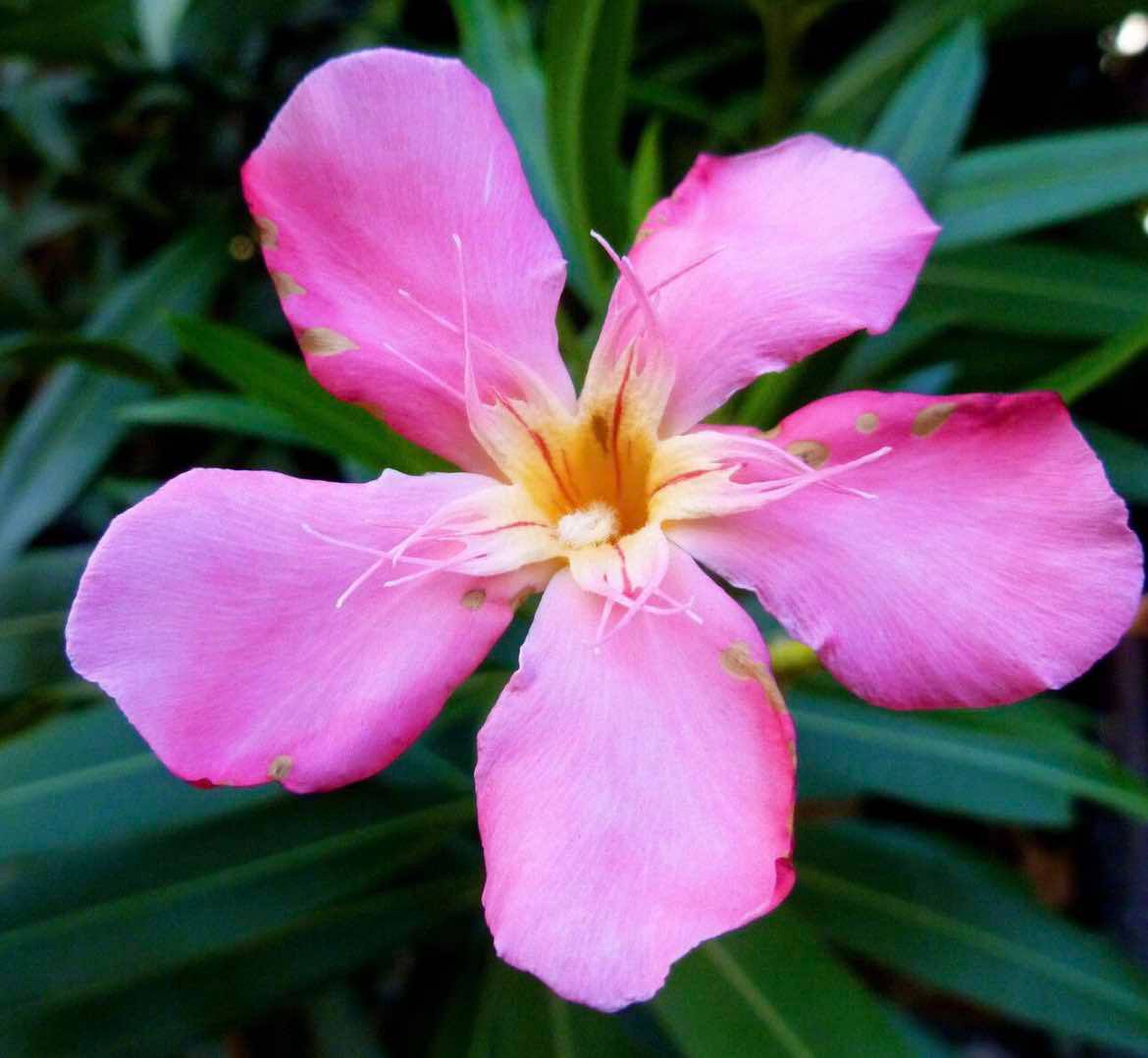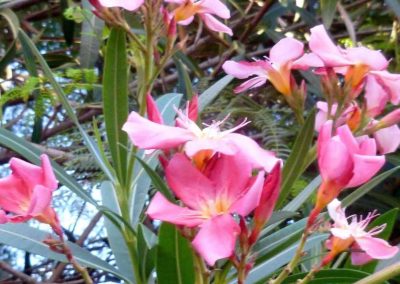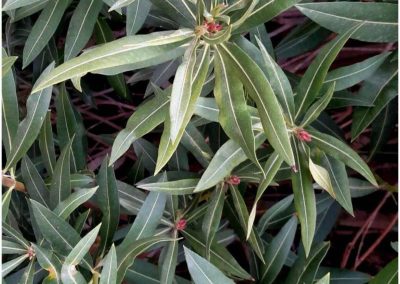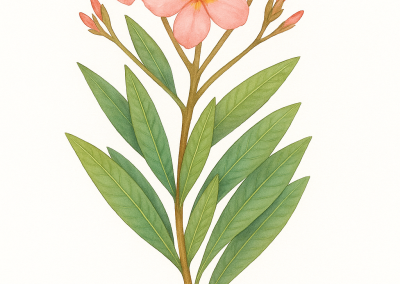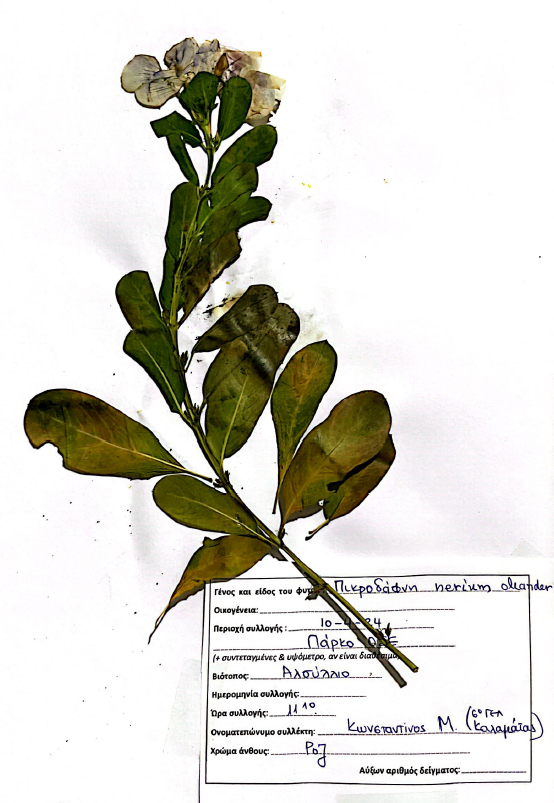Nerium oleander
Scientific description
Scientific name: Nerium oleander
Kingdom: Plants (Plantae)
Syntax: Magnoliophyta
Order: Dicotyledons, Gentianales
Family: Apocynaceae
Genus: Nerium
Species: Nerium oleander
Origin:
From the Mediterranean to western China.
Description:
Evergreen shrub up to 5 m, with toxic parts. Lanceolate, leathery leaves; single pink-red flowers. Cultivated varieties may have white, yellow, purple, or double flowers. Toxicity is due to nerine, protecting the plant from animals.
Ecology:
Native to Greece and many other regions. Prefers sunny, moist soils like riverbanks at low altitude, tolerates slightly brackish and semi-arid soils.
Propagation:
By seed or cuttings from semi-woody shoots in spring.
Use:
Horticultural uses: gardens, parks, pots, planters, borders, road islands, slope stabilization, pavements, fences. In Greece, branches are used to make wreaths for monuments to heroes.
Επιστημονική ονομασία: Nerium oleander (Νήριον το ολέανδρον)
Βασίλειο: Φυτά (Plantae)
Συνομοταξία: Αγγειόσπερμα (Magnoliophyta)
Ομοταξία: Δικοτυλήδονα (Magnoliopsida)
Τάξη: Γενθιανώδη (Gentianales)
Οικογένεια: Αποκυνοειδή (Apocynaceae)
Γένος: Νήριον (Nerium)
Είδος: Nerium oleander
Καταγωγή:
Από τη Μεσόγειο ως την δυτική Κίνα.
Περιγραφή:
Αειθαλής θάμνος έως 5 μ., με τοξικά μέρη. Λογχοειδή, δερματώδη φύλλα. Μονά ροζ-κόκκινα άνθη. Ποικιλίες με άσπρα, κίτρινα, μωβ ή διπλά άνθη. Τοξικότητα λόγω νηριίνης, προστασία από ζώα.
Οικολογία:
Αυτοφυής στην Ελλάδα και σε άλλες περιοχές. Ηλιόλουστα μέρη με υγρό έδαφος, όπως όχθες ποταμών. Αντέχει ελαφρώς υφάλμυρα και ημιάνυδρα εδάφη.
Πολλαπλασιασμός:
Με σπόρο ή μοσχεύματα από ημιξυλοποιημένους βλαστούς την Άνοιξη.
Χρήση:
Κήποι, πάρκα, γλάστρες, ζαρντινιέρες, νησίδες δρόμων, συγκράτηση πρανών, πεζοδρόμια, φράχτες. Στην Ελλάδα, κλαδιά για στεφάνια σε μνημεία ηρώων.
Nom scientifique: Nerium oleander
Règne: Plantae
Taxonomie: Magnoliophyta
Ordre: Dicotylédones, Gentianales
Famille: Apocynaceae
Genre: Nerium
Espèce: Nerium oleander
Origine:
De la Méditerranée jusqu’à l’ouest de la Chine.
Description:
Arbuste persistant jusqu’à 5 m, parties toxiques. Feuilles lancéolées, coriaces; fleurs simples rose-rouge. Variétés cultivées: blanches, jaunes, violettes, doubles. Toxicité due à la nérine pour protection contre animaux.
Écologie:
Espèce locale en Grèce et ailleurs. Lieux ensoleillés, sols humides (berge de rivière), tolère sols légèrement salins et semi-arides.
Propagation:
Par graines ou boutures de pousses semi-ligneuses au printemps.
Utilisation:
Jardins, parcs, pots, jardinières, bordures, îlots de route, stabilisation de talus, trottoirs, haies. En Grèce, branches pour couronnes sur monuments aux héros.
Denumire științifică: Nerium oleander
Regn: Plante (Plantae)
Sintaxă: Magnoliophyta
Ordin: Dicotiledone, Gentianales
Familie: Apocynaceae
Gen: Nerium
Specie: Nerium oleander
Origine:
Din Marea Mediterană până în vestul Chinei.
Descriere:
Arbust veșnic verde, până la 5 m, părți toxice. Frunze lanceolate, pieloase; flori simple roz-roșii. Soiuri cultivate: albe, galbene, violete, duble. Toxicitate datorată nerinei pentru protecție.
Ecologie:
Nativ în Grecia și alte regiuni. Locuri însorite, sol umed (maluri de râu), tolerează soluri ușor salmastre și semi-aride.
Înmulțire:
Prin semințe sau butași prelevați din lăstari semilemnoși primăvara.
Utilizare:
Grădini, parcuri, ghivece, jardiniere, borduri, insule de drumuri, susținerea pantelor, pavaje, garduri. Ramuri pentru coroane depuse pe monumente eroilor.
Creative writing inspired by Nerium oleander
Nerium oleander
Once, in a distant land of Ancient Greece, there lived a beautiful nymph named Nerion. She was known not only for her unmatched beauty but also for her independence and untamable nature. Neither mortal nor god could conquer her, for she preferred to live freely among the forests and rivers, enjoying the peace of nature.
A young hero named Oleander, captivated by the tales of her extraordinary beauty, set out to find her. He was determined to win her over with his bravery and nobility. When he finally found her by a crystal-clear lake, he was so struck by her beauty that he immediately fell in love.
However, Nerion had received many such proposals before and did not wish to be bound. Though she appreciated Oleander's courage, she refused his love. But Oleander was unwilling to let her go and began chasing her from village to village, from river to river.
Exhausted from the pursuit and seeking to escape Oleander's relentless love, Nerion prayed to the goddess Artemis. She begged to be freed and hidden from the unrequited love of Oleander. Artemis, moved by her distress, transformed her into a tall, strong plant with long, slender leaves and beautiful flowers that would bloom all year by the water's edge.
When Oleander arrived at the place where he had last seen Nerion, he found only this plant. Kneeling in despair, he realized that he had lost his beloved forever. From that moment on, the plant was called "Nerium Oleander" in honor of both Nerion, who became a symbol of freedom and beauty, and Oleander, the hero who loved her deeply but could never win her over.
The Oleander, as the plant later became known, symbolizes unattainable love and the sacrifice for freedom, with its beautiful flowers representing the sweetness of beauty but also the bitter truth of the inability to possess it.


